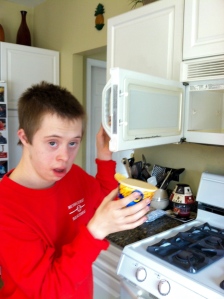Blog #116~ A New Talker for Nick
Nick has a new talker! The SETT meeting team looked at Nick’s needs as a student along with his environment, tasks he does and what tools would be needed to help him effectively communicate. Nick is using an iPad with the Touch Chat program. This Augmentative and Alternative Communication device (AAC), is bigger and the buttons are much easier to push. It has more keys on the home page making it easier for him to navigate. Each team member went through a training orientation on the device to learn how to sift through the keyboard and customize it to suit Nick’s particular needs. Nick is 21 years old and has Down syndrome and autism.
Nick’s new AAC Device….
Nick’s speech therapist introduced the device at school. He was very excited along with his peers during group. The first thing they did was to take a “selfie” of Nick (and he pressed the button) to add his photo to the personal page. This page also includes his age, the town he lives in and that he has a cat named Kibbie and assisted in getting Nick to “buy in”.
Kibbie 🙂
At home, Nick navigated through the keyboard very well. Here are some of the requests and comments he made:
*Nick pushed pulled out juice box and requested juice on talker
*Nick pushed “baseball” and walked to cabinet where they were pointing (wanting his can of tennis balls)
*Nick pushed “tired” before laid down for a nap
*Nick pushed “salami and cheese”, after nap and then pushed “soda”
*Nick pushed “salad” “mashed potatoes” as he unloaded dishwasher
*Nick pushed “phone” after his dad got off the phone to his parents and pushed Grandpa/Grandma
*Nick pushed “bathroom, shave, shower” while waiting for dinner
*Nick pushed “dessert”-Cake after dinner
We are off to a good start with Nick using the AAC device. The iAdapter case is pretty rugged, Nick’s already thrown it a few times (shocker right). However the stand that props it up has broken after taking a few hits. When he is in a throwing mood, I tuck the device out of sight so it won’t be damaged further. One thing I noticed right away was how territorial he was with it. He also found his way through the keyboard better than I thought he would. At one point he pushed the category called “Groups”. Then, he hit “Jobs” and found the “Firefighter” button which he hit a dozen times. You can view a video of this on the Facebook page: Down Syndrome with a Slice of Autism. By the way, why is there a “Pirate” is a button in the “jobs” category? 🙂
Nick fell asleep with it on the couch the first night….
Stay tuned for more about Nick’s communication device. That’s what is in my noggin this week. 🙂
~Teresa














